 |

|
 |
 |
Illustration showing the Airport within its larger context (photo: Shlomo Aronson, Barbara Aronson, Liya Kochavi). |
 |
 |
 |
 |
 |
View of entrance interchange with citrus grove (photo: Shlomo Aronson, Barbara Aronson, Liya Kochavi). |
 |
 |
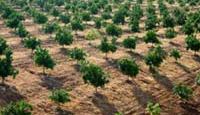 |
 |
 |
Citrus grove as seen from adjacent road (photo: Shlomo Aronson, Barbara Aronson, Liya Kochavi). |
 |
 |
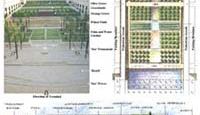 |
 |
 |
Drawings and overall view of the Central Garden from the direction of the Terminal (photo: Shlomo Aronson, Barbara Aronson, Liya Kochavi). |
 |
 |
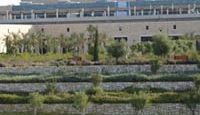 |
 |
 |
Back view of the Central Garden as seen from the Interchange (photo: Shlomo Aronson, Barbara Aronson, Liya Kochavi). |
 |
 |
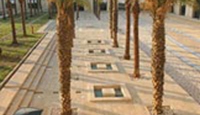 |
 |
 |
View of the 'Sea' area and the 'Sea Promenade' (as seen from the upper level of the pedestrian Arcade) (photo: Shlomo Aronson, Barbara Aronson, Liya Kochavi). |
 |
 |
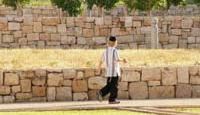 |
 |
 |
Detailed view of the terrace walls with water channels in foreground (photo: Shlomo Aronson, Barbara Aronson, Liya Kochavi). |
 |
 |
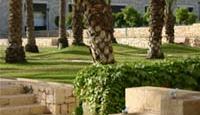 |
 |
 |
View of palm and water garden with drinking fountain in foreground (photo: Shlomo Aronson, Barbara Aronson, Liya Kochavi). |
 |
 |
 |
 |
 |
 |
 |
 |
 |
 |
|
|
 |
Israel has one main international airport, the gate for most
international air travelers. Designing this entrance to Israel
is also designing the gate to the Holy Land, a place of great
meaning for three major religions. This presented the opportunity
to create a language of style which is typical of this region
without using themes or symbols which might be off-putting
to anyone. We wanted this landscape garden to feel welcoming
for all people coming into Israel, whether they are coming
as citizens, pilgrims, tourists, or business people.
The landscape area of the airport is divided into a large
site of 65 acres which includes the interchange and approach
roads, and the courtyard-like central garden (5 acres), bounded
on one end by the main entrance way and on opposing sides
by the two large parking structures.
Shlomo Aronson Architects' overall approach to the airport
landscape design was to relate strongly to the agricultural
landscape of the surroundings: the traditional citrus groves
and agricultural fields. This was done by planting new citrus
groves on a massive scale (4,500 grapefruit and orange trees).
The trees are planted, as in a commercial orange grove, in
rows on a grid without groundcover, and plowed once a year.
Hundreds of thousands of cubic meters of soil were moved to
sculpt the gentle slopes between adjacent roads and ramps,
creating continuous ground surfaces in spite of the complex
topography of the road system. It was imperative to create
a low maintenance landscape for such a large planting as well
as low water consumption for most of the area. The citrus
groves are let to surrounding farmers who maintain the groves
in exchange for the fruit. Drought-resistant bushes were used
on slopes which were too steep to be planted with citrus groves.
The central garden is an abstraction of the natural region
with its particular topography and its man-made agricultural
development, graphically presented to the view of the passers-by.
The design is a clear summary of the physical characteristics
of the iconographic landscape from the coastal plain around
Tel Aviv up to the mountains of Jerusalem. Just as in the
real landscape, the garden begins with the sea, followed by
palm and citrus groves, past agricultural fields, and up to
the olive groves and cypresses of the Judean Hills. As the
newcomer leaves the airport, he might well travel immediately
through the real landscape as it is represented in the airport
garden.
The central garden area was tilted down toward the terminal,
divided in terraces rising to the back to a total height of
5 meters, and cut sharply at the edges to emphasize the abstract
quality of this discrete landscape piece. The various landscape
units representing the ascent from Tel Aviv to Jerusalem are
presented in a formal and minimalist way as monochrome abstractions
of the plant material or ground conditions typical of each
landscape zone. As the garden is viewed from different directions
and eye levels, the passer-by collects picture-book-like images
of the abstracted landscape.
Water was used in a traditional Mediterranean way, running
in narrow channels with short falls. Local limestone was used
both in the paving and the walls, using different dressing
types for specific effects. At the base of the central garden,
stainless steel was used to evoke the feeling of waves hitting
the beach.
For ages the ascent to Jerusalem has been a treasured way.
By incorporating this experience into the garden it is hoped
that the traveler will have a deepened feeling for this place
wherever he may go.
The Forestry Commission
will provide early-stage management assistance with thinning,
white-tail
deer and other nuisance
species control, nutrient, and irrigation programs. In addition
to construction of all ground surfaces (Summer 2005), Pulaski
County and the City of Little Rock public works staffs
will
partner to plant and maintain the formal allées with
mature trees (Fall 2005 and Spring 2006). The Garden of Trees
will be an important social anchor and rest stop along the
county’s 31-mile bicycle trail, and a catalyst for
the extension of its arboreal patterns throughout the river
valley
recreation corridor.
The Pulaski County administration is assembling an independent
501(c)3, or non-profit, organization—Friends of the
Garden of Trees—to sponsor and administer the Garden
once the first phase of planting and construction is completed.
Such organizations allow visionary projects developed within
local government administrations to persist beyond a founding
personality regardless of future governing administrations.
Discussions are under way with the State’s flagship
University to establish a horticultural development and learning
lab, sharing project stewardship with Friends of the Garden
of Trees. Donors are currently being solicited for funding
of various Garden Rooms and trails.
|
|
|
|
 |
 |
 |
 |
 |
 |
View of palm and water garden (photo: Shlomo Aronson, Barbara Aronson, Liya Kochavi).
|
 |
 |
 |
 |
 |
View of 'Grasslands', citrus grove and palm garden (as seen from the upper level of the pedestrian Arcade) (photo: Shlomo Aronson, Barbara Aronson, Liya Kochavi).
|
 |
 |
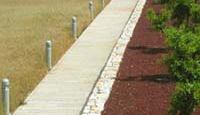 |
 |
 |
Detailed view of stone-paved path and terrace wall separating the wheat field from the citrus grove (as seen from the upper level of the pedestrian Arcade) (photo: Shlomo Aronson, Barbara Aronson, Liya Kochavi). |
 |
 |
 |
 |
 |
View of wheat field (photo: Shlomo Aronson, Barbara Aronson, Liya Kochavi). |
 |
 |
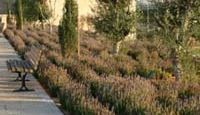 |
 |
 |
View of olive and cypress trees with lavender as ground cover (seen from the upper traversing viewing terrace) (photo: Shlomo Aronson, Barbara Aronson, Liya Kochavi). |
 |
 |
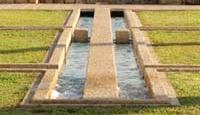 |
 |
 |
Detail of central distribution pool, with source pool in background (photo: Shlomo Aronson, Barbara Aronson, Liya Kochavi). |
 |
 |
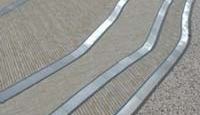 |
 |
 |
Detailed view of 'Sea' Area with stainless steel 'waves', stone-paved 'water', and river pebbles in 'Beach' Area (photo: Shlomo Aronson, Barbara Aronson, Liya Kochavi). |
 |
 |
|
 |